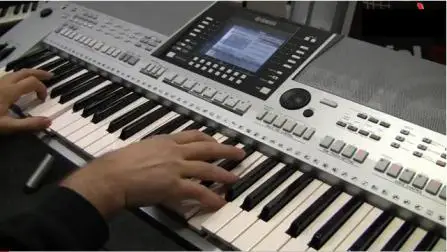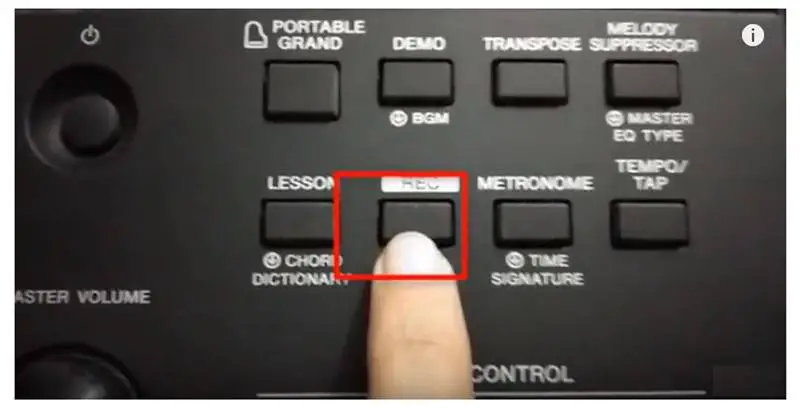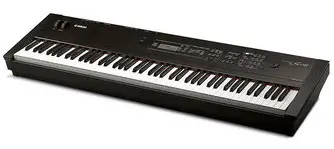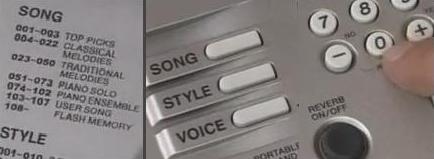
Music Keyboards come with recording functions as well, in addition to several other features. Most keyboards come with a built-in sequencer that lets you record your musical ideas. The concepts explained here applies to most brands of music keyboards, including Yamaha and Casio. Learn how to record on your digital piano keyboard. You can record songs, musical styles and more on the keyboard itself.
Introduction
While you can always connect a digital piano/keyboard to a computer and save things on the computer, at times its just a lot more convenient to record things on the instrument itself.
- For instance, if you want to record your performance and play it back to review it, its convenient to do it on the keyboard itself.
- If you want to quickly record a musical idea, its easier to do it on the instrument
- If you want to practice recording songs by laying one track at a time, its convenient to first learn how to do it on the keyboard instrument, before you begin practicing on a computer (using a recording software)
You can record several performances (the number depends on the keyboard model) and save them as user songs on the keyboard, which can then be played back on the instrument.
On some keyboards, you can even record to the memory banks for easy recall later on.

Introduction to Sequencer
When you start learning electronic keyboards, the keyboard features that you will use the most are the various voices & styles, and the accompaniment section. Playing the melody on top of the various accompaniments is what most students enjoy doing on a electronic Keyboard.
But there is another important feature that you will find on most of the portable keyboards…and that is the Sequencer.
What is a Sequencer?
A sequencer is nothing but a built-in recorder, which lets you record your musical ideas. This is something which you may not use a lot as a beginner but once you get to the stage where you start composing tunes, this little tool will come in handy.
You may hear terms like 2-track sequencer, 5-track sequencer etc. It simply means that you can record the backing tracks as well for your music. The melody goes on one track and the rhythm can be recorded on the other tracks.
Now you can record your ideas whenever a tune hits your head.
Video showing how to use songs and recording functions on a Yamaha keyboard
Create Full Fledged Songs
The better models come with 16-track sequencer and comprehensive editing features so that you create complex arrangements. 16 tracks mean you can actually use few tracks for drums and bass, few tracks for chord instruments, which still leaves you with more tracks to add instruments as per your choice. Usually, boards with 16-track sequencers also have a higher polyphony so that you don’t run out of notes when creating complex arrangements.
In fact, most of the demo songs built-in an electronic keyboard are actually made using the sounds and styles available on the keyboard, so that’s what you should aim for when creating your own songs.
Playback MIDI/Wav Files
Depending on the Yamaha keyboard you choose, the sequencer may also be able to play back standard MIDI files or Wav files directly from a memory card.
In this case, a bundled software will be provided when you buy the keyboard that will help you easily load the songs on a SmartMedia card using your computer (PC or Mac).
You can straightaway use those sequenced accompaniments/songs, either for practicing at home, or for performing live. Isn’t that a cool feature?
Its very easy to playback the songs or to create new songs.
Learning from the Built-in Songs
 Another interesting feature on any Yamaha digital keyboard is their collection of built-in songs and the song recording feature (also known as the sequencer).
Another interesting feature on any Yamaha digital keyboard is their collection of built-in songs and the song recording feature (also known as the sequencer).
Along with the several Voices and Styles that are available on music keyboards, you will also find several built-in songs, plus you also have the ability to add your own songs on your keyboard.
There are several ways in which you can use the built-in songs to your advantage.
You can listen to these songs and get entertained and at the same time appreciate the sound quality of your keyboard, or you can play along if you have been taking piano keyboard lessons for some time, or even if you have just started taking piano lessons, you can still learn these songs using the Yamaha education suite, which is Yamaha’s built-in keyboard lessons
There are many songs and could vary depending on the Yamaha keyboard model that you have bought. On some models, you could find more than hundred.
As with the Voices and Styles the songs are grouped under various categories for easy recall. You can find categories like Top Picks, Classical melodies, Traditional melodies, piano solo, piano ensemble, User songs, etc.
Amazing Grace is one song that you will find on almost all the Yamaha portable keyboards.

How Does it Work?
Listening to the songs is very easy, and there are a couple of ways to use this feature.
You can either use the dedicated DEMO button, which is available on your keyboard, which will play all the built-in songs in sequence, one after the other.
Just sit back and enjoy. With the press of a button, your keyboard will entertain you with all the songs.
When looking for a new Yamaha keyboard, the easiest way to check out its capabilities is to hit the DEMO button. Usually the built-in songs use the voices and styles of that particular model itself.
But if you want to hear a specific song, then you need to enter the number of the song. As with Voices and Styles, songs are also accessed using the Song button. Just enter the number of your song or use the plus and the minus buttons to select your song.
Recording Your Own Song
Electronic keyboards also let you store your own recorded songs. These are stored under the category “User Songs” mentioned above.
Recording a song is very easy.
You just have to press the Record Button, which enables the Record mode, and then it will record whatever you play.
You can set ON the metronome (if you wish to) and start playing. Once you are done playing you can hit the STOP button, in which case the keyboard will start writing/saving your song in the memory.
If you want to hear back your recorded song, you just have to hit the START button.
You can record anything – you can either play solo, or you can select your favorite style and then play on top of it. Your song will be recorded and save on the Yamaha keyboard.
Basic Steps to Record a Song on a Keyboard
While the exact steps may vary a bit depending on the keyboard (Casio, Yamaha, etc.), the concept remains more or less the same.
- You start by pressing the ‘REC’ button (which indicates you are ready to start recording).
Entry level keyboards may not allow you to record one track at a time, in which case the keyboard records whatever you’re playing (your entire performance), which you can play it back.Higher models allows you to record one track at a time, in which case you to press “REC” button and the track on which you wish to record. Once done, do the same for another track.
- Start recording one track at a time (press “REC” button plus the track), until all the tracks are covered.
- A number is allocated to the (user) song, and the entire performance/song will be stored as one of the user songs
- The song can be played back by pressing the ‘START’ button (if you’re currently on a different song, you will have to first select your song from the user songs)
This is how it works on most keyboards.
Begin Learning Recording Skills on Your Digital Keyboard
If you are just a beginner in music production, before you invest in any software/hardware for your studio, spend some time creating user styles on your keyboard. You can easily brush up your skills here without spending on additional gear.
Learn how melodies, chords, rhythm, drums, percussion, etc. come together on the various tracks. You can even try taking an existing style and make it sound better by re-arranging the various parts.
As you become better, you can then think of moving to the computer domain and get the various software and recording gear.
How to record on Yamaha Keyboard
Learners: Start with the Basics
If you are planning to buy a new Yamaha Portable Keyboard, just do not get tempted with the top-of-the-line models. It is very easy to get attracted by their mind blowing features but you need to be a bit rational in your approach.
It will be prudent on your part to focus on learning right now, and get yourself an advanced keyboard once you have mastered the instrument.
Having said that, try to get a model that has several features, if it fits within your budget!
You’ll learn about the various musical styles, how they sound, which instruments sound good with those styles, and more.
Experienced Players: Aim to Expand Your Skills
If you are an experienced player, professional, or a semi-professional, you will always have to be on the lookout for newer sounds and newer technologies, which will help you professionally and also make your work stand out from others.
If you want to take the performance route and don’t want to get into the nitty-gritties of technology, the only way out is to become a better player and augment your repertoire of songs and the styles in which you can play/accompany others.
Summary
Besides getting entertained, the song recording feature on electronic keyboards is an excellent way to practice as well, especially if you don’t have your piano teacher around to point out your mistakes. You can even learn these songs at your own pace with the built-in education suite. So go ahead and use this feature to the fullest on your music keyboards.
Portable keyboards (Yamaha, Casio and others) are available in various sizes (more than 61 keys as well) and come with many advanced music recording features. The built-in sequencer is a handy tool that can be used to record your musical ideas, whenever something brilliant hits your head. As usual, be prudent with your purchase and look for features that you can really use and appreciate.
KeytarHQ editorial team includes musicians who write and review products for pianists, keyboardists, guitarists & other musicians. KeytarHQ is the best online resource for information on keyboards, pianos, synths, keytars, guitars and music gear for musicians of all abilities, ages and interests.



Leave a Reply